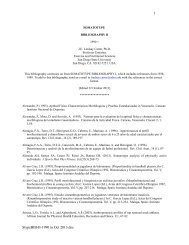THE HEATH-CARTER ANTHROPOMETRIC ... - Somatotype.org
THE HEATH-CARTER ANTHROPOMETRIC ... - Somatotype.org
THE HEATH-CARTER ANTHROPOMETRIC ... - Somatotype.org
You also want an ePaper? Increase the reach of your titles
YUMPU automatically turns print PDFs into web optimized ePapers that Google loves.
<strong>Somatotype</strong> Instruction Manual 8<br />
If the calculation for any component is zero or negative, a value of 0.1 is assigned as the<br />
component rating, because by definition ratings cannot be zero or negative. The photoscopic rating<br />
would be one-half (½). If such low values occur the raw data should be checked. Values less than 1.0<br />
are highly unlikely to occur for endomorphy and mesomorphy, but are not unusual for ectomorphy.<br />
Component ratings should be rounded to nearest 0.1 of a unit, or nearest half-unit depending on their<br />
subsequent use.<br />
After the values are entered into the equations (either by calculator or computer program) rather<br />
than onto the rating form, it is impossible to check the pattern of values in either the endomorphy or<br />
mesomorphy section as in the rating form, although the raw values can be examined for errors. This is a<br />
limitation of using the equations. Further checking can be done for either method by using the HWR<br />
and by plotting the somatotype.<br />
There is a relationship between the HWR and the likely somatotypes (see Fig. 4). The<br />
somatotypes in the rows are those most likely to occur for the given HWR. For example, given a HWR<br />
of approximately 49.6, the most likely somatotypes are 1-1-8, 1-2-9 or 2-1-9. (The hyphens are left<br />
out of the somatotypes to conserve space.) The next most likely somatotypes are those in the rows<br />
directly above and below the row for 49.6. If none of these somatotypes match or are not close when<br />
interpolating for half-unit ratings, there may be errors in the data or calculations. However, other factors<br />
such as heavy meals or dehydration can affect body weight sufficiently to alter the "normal" HWR.<br />
For subject 573, HWR = 43.4, and Figure 4 shows that in the row for a HWR of 43.64 the<br />
somatotypes 1-6-3 and 2-5-3 occur. His 1½-5½-3 is a combination of these two ratings, therefore his<br />
anthropometric rating agrees with that expected from the HWR table. For subject B-188, HWR =<br />
45.6, her 3-2-5 somatotype appears in the row above that for her HWR. Her ectomorphy is<br />
borderline between 4½ and 5, which suggests that she might be a 3-2-4½, i.e. half way between the<br />
two rows. The somatotypes for both subjects appear to be reasonable.<br />
[A program for calculating individual and group data is provided in a Microsoft Excel © program, HC-<br />
Stype Calculator.xls. See Part 3.]<br />
Plotting the <strong>Somatotype</strong><br />
Traditionally, the three-number somatotype rating is plotted on a two-dimensional somatochart using<br />
X,Y coordinates derived from the rating (see Fig. 4). The coordinates are calculated as follows:<br />
X = ectomorphy - endomorphy<br />
Y = 2 x mesomorphy - (endomorphy + ectomorphy)<br />
For subject 573, X = 1.5, and Y = 6.5. For subject B-188, X = 2.0, and Y = -4.0. These points on<br />
the somatochart are called somatoplots. If the somatoplot for the subject is far from that expected<br />
when compared to a suitable reference group, check the data and calculations. Because Figure 5 is<br />
quite crowded with numbers, the final somatoplots could be projected onto a somatochart without the<br />
numbers. Figures 6a,b are two blank somatocharts, one with printed somatotypes and one without.<br />
These may be copied for use.<br />
Other versions of the rating form may be used instead. See Fig. 3, p. 153 in Carter (1996) for the<br />
adaptation by Tim Olds. For descriptions and illustrations in Spanish of the anthropometric somatotype<br />
rating form and somatocharts refer to the web site of Mariano A. Godnic (ARG), www.nutrinfo.com.ar.<br />
The <strong>Somatotype</strong> Photograph<br />
3/19/2003




